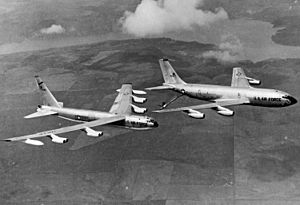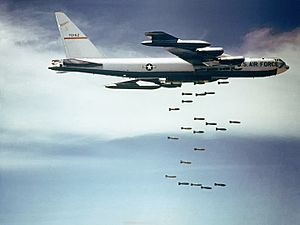Blytheville Air Force Base facts for kids
Quick facts for kids Eaker Air Force BaseBlytheville Air Force Base Blytheville Army Airfield |
|
|---|---|
| Part of Strategic Air Command/Tactical Air Command | |
| Blytheville, Arkansas | |
| Coordinates | 35°57′52″N 89°56′38″W / 35.96444°N 89.94389°W |
| Type | Air Force Base |
| Site information | |
| Controlled by | 461st Bombardment Wing (1956–1958) 97th Bombardment Wing (1959–1991) |
| Site history | |
| Built | 1942 |
| In use | 1942–1946, 1953–1992 |
Blytheville Air Force Base was a special place for the United States Air Force from 1942 until it closed in 1992. In 1988, it was renamed Eaker Air Force Base to honor Ira C. Eaker, a famous general from World War II. This base was located about 3 miles (4.8 km) northwest of Blytheville, Arkansas. Today, the area is used as the Arkansas Aeroplex and Arkansas International Airport.
Contents
History of Eaker Air Force Base
The land for the base was originally farmland. It became an airfield called Blytheville Army Airfield in 1942. During World War II, it was a training center for pilots. This was part of a big program to train 70,000 pilots for the war. Many airfields like this were built in the middle of the country. Blytheville was chosen because it was close to the Mississippi River. This made it easy to move supplies by boat.
The airfield was a flight training school for the Southeastern Training Command. This school closed in October 1945 after World War II ended. After that, the airfield briefly helped military members go home after the war. The government officially closed the base in 1946. The city of Blytheville then took control of the land.

On July 15, 1955, the base reopened as Blytheville Air Force Base (AFB). The 461st Bombardment Wing moved there from Hill Air Force Base in Utah. Blytheville AFB became fully active on July 19, 1955. It received a group of B-57 bomber planes. Other planes at Blytheville AFB included the KC-97 refueler, B-52G bomber, KC-135A tanker, T-33 jet fighter, and the T-37 trainer.
In July 1959, the 97th Bombardment Wing took over the base. They brought the long-range B-52G bomber and the KC-135A Stratotanker. These planes helped refuel the bombers in the air. Blytheville AFB was very busy during the Cold War. For example, during the Cuban Missile Crisis on October 22, 1962, the 97th Bombardment Wing went on high alert. Two B-52G bombers were ready to attack the Soviet Union if needed. The wing received an award for their actions during this time.
During the Vietnam War, the 97th Bomber Wing at Blytheville helped with bombing missions. This was in the late 1960s and early 1970s. A bomber crew from Blytheville was among the first shot down during Operation Linebacker II. This mission in December 1972 targeted areas in North Vietnam. Three crew members died in the crash. Six more men from the 97th were also lost in Vietnam. Their names are on a memorial at the old base. In 1972, all the bombers moved to Guam for a short time. They then returned to Blytheville AFB, and the base went back to normal operations.
The base also launched rescue missions to Grenada in 1983. In August 1990, pilots from the 97th Bomber Wing began practicing for missions in the Middle East. They later supported Operation Desert Storm.
Renaming and Closure of the Base
In 1988, the U.S. Air Force officially renamed Blytheville AFB to Eaker AFB. This was to honor General Ira Eaker from World War II. People hoped the new name would help keep the base open. But, Eaker Air Force Base was still on the list of bases to close in 1991. The Cold War was ending, so many bases were closing. In March 1992, the last aircraft left the base.
Local and federal officials worked hard to help the community of Blytheville. They cleaned up the base and gave the land to different groups. These included the Department of the Interior, the Fish and Wildlife Service, and the Department of Veterans Affairs. Some of the land has even been named a National Historic Landmark.
The base closing meant over 700 civilian jobs were lost. But about half of these jobs were replaced. The old base was used for new things. For example, the United States Postal Service used it as an airport hub during holidays. Some of the base housing became a retirement community. The local community built a $2.5 million sports complex. Also, private investors spent $3 million to create the Thunder Bayou Golf Course.
Historic District
The Blytheville Air Force Base Strategic Air Command (SAC) Alert and Weapons Storage Areas Historic District was added to the National Register of Historic Places in 2018. This historic area covers 247 acres (100 ha). It includes 23 important buildings, 33 structures, two sites, and one object that tell the story of the base.
Major Aircraft Used at the Base
- North American AT-6
- Curtiss AT-9
- Beech AT-10
- Republic AT-12
- North American TB-25
- Curtiss C-46
- Douglas C-47
- Martin B-57 Canberra
- Boeing B-52G Stratofortress
- Boeing KC-135A Stratotanker
Images for kids






